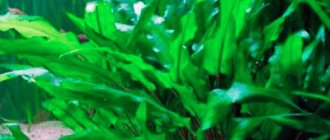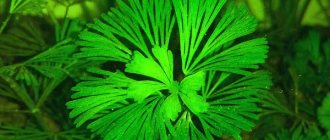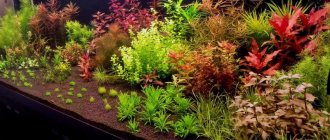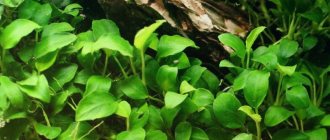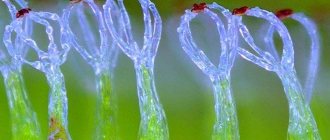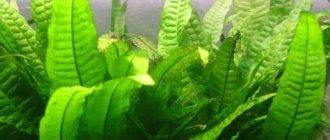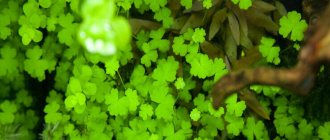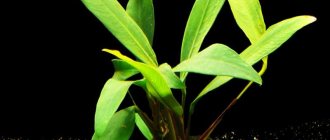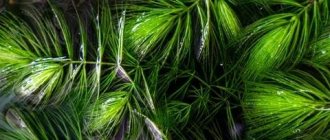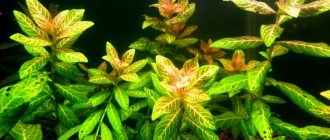Cryptocoryne is one of the most common aquarium plants. The abundance of varieties of this plant is simply amazing - there are countless of them. Here are the main types of cryptocorynes: Cryptocoryne aponoghetonolifolia And Cryptocoryne Blassa Cryptocoryne splendor And Cryptocoryne long-tailed Cryptocoryne ellipticus And Griffith's Cryptocoryne Cryptocoryne tongue-shaped And Cryptocoryne small Cryptocoryne Nura And Cryptocoryne Petch Cryptocoryne ribbed Cryptocoryne ciliata Cryptocoryne related and Cryptocoryne cordata Cryptocoryne clowniformes And Cryptocoryne siamese Cryptocoryne sipral And Cryptocoryne Thwaiteza Cryptocoryne auricularis vesicularis Cryptocoryne Walker and Cryptocoryne Versteeg Cryptocoryne Willis and Cryptocoryne Johor
Cryptocoryne Beckett
A beautiful ornamental plant in addition to relatively uncomplicated maintenance conditions. Its leaves are compactly collected in a rosette and have different colors on both sides. Cryptocoryne Beckett is a low plant (up to 12 cm), so it is perfect as a decoration for the foreground and middle ground of an aquarium, forming small thickets. The plant goes well with any aquarium plants.
Genus: Cryptocoryne.
Family: Araceae.
Habitat: marshy ponds of the island of Sri Lanka.
Appearance: herbaceous bush, the stem is not pronounced. The leaves are in the form of a rosette, on low petioles that grow immediately from the root. The leaf shape is heart-shaped. The outer side of the leaf blade is soft olive in color, the inner side is red-brown. In an aquarium, the plant grows no more than 12 cm. The flowers are pale yellow.
Soil: nutritious. Substrate - coarse river sand and/or small pebbles. Before planting, a mixture of boiled peat, clay and charcoal must be added to the bottom of the planting hole. An alternative could be garden soil. The soil should be laid 5-8 cm thick. The plant can be planted in a clay pot and then placed on the bottom of the aquarium, camouflaged in a suitable place. Cryptocoryne does not require regular fertilization.
Lighting: average, direct sunlight is not allowed. If the aquarium lighting is bright, Cryptocoryne Beckett should be hidden in the shade of taller plants. Fluorescent lamps are preferable. The duration of daylight is at least 12 hours.
Water parameters:
Comfortable temperature: 24-28 °C. The plant will be able to withstand temperatures dropping to 20-22 °C, but its growth will slow down significantly.
“Acidity” Ph: neutral or slightly alkaline Ph 7.0-7.5.
Hardness dH: average 8-16 dH.
When water hardness and acidity decrease, “cryptocoryne disease” can develop. A change in these parameters can occur as a result of changing or adding water, so they must be adjusted in advance.
Placement in an aquarium: a tropical aquarium with a volume of over 40 liters is suitable. Cryptocoryne Beckett looks good in the front or center of the aquarium, next to various driftwood and decorative roots.
Reproduction: vegetative, root layering.
Cryptocoryne purpurea
Genus: Cryptocoryne.
Family: Araceae.
Other names: K. Griffith's plant, Cryptocoryne cordate. Depending on the conditions of its maintenance, the plant changes greatly in appearance, so confusion often arises in determining the species.
Habitat: Malaysia.
Appearance: herbaceous bush about 40 cm high. The plant has long oval leaves, collected in a rosette. The leaf plate on the front side is in various shades of green, and on the inside there are many variations of red.
Root system: well developed.
Soil: nutritious, heavily silted, at least 7 cm thick. The composition of the substrate does not matter, since the plant has a powerful root system. When planting Cryptocoryne, clay should be added to the bottom of the hole, adding peat or silt from another aquarium. Periodically, the plant should be fed with mineral fertilizers.
Lighting: Cryptocoryne cordate is not demanding on lighting; natural light is enough for her, and even in the shade she can feel absolutely comfortable. But this does not mean at all that the plant will delight you with its excellent appearance; it will become pale and elongated. It will be much better if Cryptocoryne is provided with good artificial lighting. To do this, you will need fluorescent lamps of the LD and LB type with a power of 0.3-0.4 W / 1 l or incandescent lamps - approximately 1 W / 1 l.
Water parameters:
Comfortable temperature: 24-26 °C, although 20-28 °C is acceptable. When the water temperature drops, the plant's growth slows down.
“Acidity” Ph: slightly acidic or neutral.
Hardness dH: low, 2-10°. As hardness increases, the plant becomes smaller.
Cryptocoryne purpurea is almost not afraid of changing water, only in very bad conditions does it shed its leaves. People rarely get sick with cryptocoryne disease.
The plant feels good in old water; after changing it, it does not grow for some time.
Placement in the aquarium: in the center of the aquarium or in the background near the side walls.
Reproduction: vegetative, root layering.
In a humid greenhouse, Cryptocoryne cordate develops more actively. The plant is transferred to a less humid environment gradually; the water level decreases evenly with the appearance of young leaves. When Cryptocoryne is happy with everything, it grows and blooms quickly.
If you take a plant from a paludarium, then it can be placed in an aquarium without adaptation.
Cryptocrine diversity
Cryptocoryne lucens de Wit. (Fig. 95).
Rice. 95. Cryptocoryne brilliantis
The homeland of this plant is unknown, but it is assumed that Fr. Sri Lanka. Despite the low-growing appearance, the root system of the plant is well developed, the roots are fleshy and white. The plant tends to form a rhizome not only due to dying leaves, but also due to a large number of shoots developing in the immediate vicinity of the mother plant. Therefore, the rhizome can have different shapes.
The plant reaches 15 cm in length. The leaves are up to 7.5 cm long, less than 1.2 cm wide. The leaves are medium to dark green in color with a glossy sheen, narrowly lanceolate, pointed bases, smoothly turning into petioles. The leaves become narrower towards the tops and end with blunt ends. The leaves sit on green petioles. The length of the petiole is equal to or greater than the length of the leaf. The main vein of the leaf is well expressed, the lateral veins are weak. The flower is straight tubular at the base and thickens towards the throat of the flower. The opened flower is a thick mauve color with a bluish-red throat.
It grows and reproduces better when kept in a humid atmosphere and the root system is immersed in water. The temperature of water and air in summer is 25° C, in winter 18–20° C, the soil is oily clay, the lighting is moderate. When submerged, the plant reproduces by ground shoots and grows slowly.
Cryptocoryne yellow - Cryptocoryne lutea Alston (Fig. 96).
Rice. 96. Cryptocoryne yellow
Distributed throughout the swamps and lowlands of the island. Sri Lanka. Leaves with petioles reach 15 cm in length.
The root system is poorly developed and consists of one fibrous root lobe, the stem is straight and short. Leaves are lanceolate, up to 7 cm long, 2 cm wide. The bases of the leaves are ovally narrowed, the leaves smoothly narrow towards the tops, green above, pale red below. The main vein of the leaf is clearly visible, with a brown tint on the upper side, the lateral veins are weakly expressed, the length of the petiole is equal to the length of the leaf.
Floral organs are up to 6 cm long, the opened flower is lanceolate, slightly curled, its inner part is green-yellow to yellow. Under optimal submerged conditions, plants are smaller in size than those grown in a humid atmosphere.
The plant is best cultivated unsubmerged in a humid atmosphere and shady conditions. When the plant reaches normal development, it is transferred to an aquarium. When submerged it grows slowly. Easily propagated by ground shoots; daughter plants develop in close proximity to the mother plant. The plant must be protected from direct and prolonged exposure to sunlight.
Small Cryptocoryne - Cryptocoryne minima Ridley (Fig. 97).
Rice. 97. Cryptocoryne small
Distributed on the Malay Peninsula. It grows along the banks of slow-moving streams and is well shaded by large plants. Leaves with petioles reach 8 cm in length.
The root system is poorly developed, the roots are thin, white, do not go deep into the ground, the stem is straight and short. The leaves are oval-elongated, the bases are rounded. Towards the top, the leaves smoothly narrow and turn into a point, the length of the leaf is up to 5 cm, the width is 1.5 cm. The upper side of the leaf is light chocolate color with a very pleasant shade of color, the lower side is purple-crimson, the edges are slightly wavy, the main vein is well defined, lateral – weak. The leaves sit on short brown petioles. This plant is best cultivated in a humid greenhouse, but it also grows well in a shallow aquarium submerged in soft water and moderate light. You need to add fatty clay to the soil. It reproduces vegetatively, but very slowly; during the year you can get up to 5 ground shoots, which also develop slowly. Daughter plants emerge from the soil in close proximity to the mother plant. Overgrown plants are very decorative.
Cryptocoryne Nevillii Trimen (Fig. 98).
Rice. 98. Cryptocoryne Neville
Widely distributed throughout the swamps of the island. Sri Lanka. It varies greatly depending on growing conditions. This plant is small. Leaves with petioles reach up to 12 cm in length.
The root system is very well developed, the roots are fleshy, white, the rhizome is knotty and consists of several lobes. The number of lobes is directly proportional to the number of daughter plants that grow in close proximity to the mother bush. Leaves are up to 6 cm long, less than 1.5 cm wide, lanceolate. The bases of the leaves are rounded, towards the top the leaves become narrower and end with pointed ends. The upper side of the leaf is smooth, juicy green, the lower side is light green; the main vein is well expressed, the lateral veins are poorly visible; petiole green. The length of the petiole is equal to the length of the leaf or slightly longer. Flower organs up to 8 cm in length. The throat of the flower is lanceolate, up to 2 cm long, in the expanding part it is pale brown with a reddish-purple tint and has a yellow throat. In addition to the main form Cr. Nevillii Trimen, a plant form known as Cr. Nevillii Trimen f. Pigmy. It is not permanent and may return to its main form over time. A plant of this form bears leaves up to 3 cm in length and less than 1.3 cm in width, the base of the leaf is rounded and narrowed. Towards the top, the leaves gradually taper and become a point, the petiole is longer than that of the main form. The species and shape are very common and are often found among aquarists. Plants can be kept either unimmersed or submerged, but they grow and reproduce faster in an unimmersed state. Soil – fatty clay, peat chips. The plant must be protected from direct, prolonged sunlight. During the growth period, it requires moderately warm conditions and average lighting.
Cryptocoryne Nurii Furtado (Fig. 99).
Rice. 99. Cryptocoryne Nura
The plant bears narrow oval leaves up to 10 cm in length, which are narrowed at the base and towards the apex. The edges and partly the surface of the leaf are wavy; in some areas of the leaf the surface is very rough. Depending on the cultivation conditions, the color of the leaves varies from dark green to light brown, purple-brown with spots at the main vein. In mature plant specimens, shiny red spots may appear on the leaves. The ratio of sheet length to width is 3.2:1. The length of the petiole is approximately equal to the length of the leaf. The plant can grow in open and closed ground.
It is better to cultivate in open ground in a very humid atmosphere. Under these conditions, the plant must be protected from direct sunlight. A plant immersed in water grows slowly; feels better in soft water, but can grow in moderately hard water.
Petch's Cryptocoryne Petchii Alston (Fig. 100).
Rice. 100. Petch's Cryptocoryne
Distributed throughout the swamps of the island. Sri Lanka. Leaves with petioles reach 25 cm in length.
The root system consists of one lobe of highly developed roots. The stem is straight, short. Leaves are up to 12 cm long, 2.5 cm wide, lanceolate, the base of the leaf is usually rounded, less often heart-shaped, the leaves become narrower towards the apex; the edges are wavy, light brown to brown above, often with transverse streaks, light pink to pink-violet below. The petiole is equal to the length of the leaf. The main vein is well expressed, the lateral veins are weak; a total of 3–5 veins are visible. The flower part has the appearance of a straight tube, the throat of the flower is dirty yellow, the petal is ovoid in shape, with a downward curved end. This plant reproduces by ground shoots, young offspring grow at a short distance from the mother plant. Petch's Cryptocoryne tends to form thickets.
The plant grows and reproduces well in normal aquarium conditions. To be kept unimmersed, a relatively cool environment is required (temperature no more than 24° C), natural, diffuse lighting. An increase in temperature destroys the unimmersed plant. Lighting should be moderate (preferably a shady place). Depending on the conditions of its maintenance, the plant changes the shape, color and size of the leaves.
Cryptocoryne purpurea Ridley (Fig. 101).
Rice. 101. Cryptocoryne purpurea
It is distributed on the islands of the Malay Archipelago and belongs to one of the beautiful species of this genus. Leaves with petioles reach 30 cm in length; The rhizome is knotty, brown to dark brown in color, adventitious roots are well developed, the stem is straight and short. The leaves of young plants are narrowly oval in shape, the base is oval and narrowed, the apex is sharp, the upper side of the leaf is green with transverse brown-red strokes, the underside is pink.
In an adult plant, the leaves are fleshy, ovoid, the base is rounded to heart-shaped. Towards the top, the leaves become narrower and end with a blunt pointed end, the upper side is dark green to brown, sometimes with a silvery tint, with pronounced transverse black strokes, the lower side is bright purple. The ratio of length to width of the sheet is 2.5:1. The leaves sit on petioles, the length of which is equal to the length of the leaf. Flower organs up to 30 cm in length. The petal of the opened flower is oval-shaped, up to 7 cm long and ends in a small tail, the inner part of the flower is uneven, covered with purple-red tubercles, at the throat it is purple with a yellow tint.
This plant is very difficult to cultivate. It grows best in a non-immersed state and in a very humid atmosphere, which can be created if the plant is covered with a glass cover or kept in a greenhouse, in a shaded place, at moderately high water and air temperatures. As the plant grows, the water level increases; for adult specimens, the water level should be 10 cm.
The soil used is a mixture consisting of fatty clay, peat and river sand. When kept in such conditions, the plant develops well and relatively easily produces ground shoots, which should be separated from the mother plant with the development of at least three leaves.
The plant can also be kept immersed in water, but then it grows very slowly, and reproduces by ground shoots even less often, no more than 3 plants per year. Cultivating this type of plant in an aquarium can only be recommended to experienced specialists or amateurs, since maintaining the plant requires a lot of care.
Cryptocoryne retrospiralis (Roxburgh) Fischer ex Wedler (Fig. 102).
Rice. 102. Cryptocoryne reverse spiral
The homeland of this species is India (Ganges River) and the Malacca Peninsula. Leaves with petioles reach up to 45 cm in length.
The root system is well developed and consists of rhizomes with adventitious roots, the stem is straight and short. The petiole is significantly shorter than the length of the leaf.
Leaves are up to 30 cm long, 1.5 cm wide, linear, narrow at the base and smoothly turn into a petiole, the apex is sharp, the edges are slightly wavy. The upper and lower sides of the leaf are olive green. The main vein is well defined; on the upper side of the leaf it is slightly depressed, forming a groove along its entire length; the lateral veins are faintly visible.
The floral organs are long, ribbon-shaped, spirally twisted up to 20 cm in length, the throat of the flower is linear in shape up to 8 cm in length, spirally rotated, with a very elongated middle floral part, reddish in color inside. Propagated by ground shoots and division of rhizomes. This plant loves deep, soft, warm, slightly acidic water. The plant is not cultivated in an unimmersed state.
Cryptocoryne reverse spiral is unusual in shape and looks very decorative.
Cryptocoryne scurrulis de Wit (Fig. 103).
Rice. 103. Cryptocoryne clown-like
Distributed throughout swamps and swampy areas of the island. Sumatra. The description of this species is based on the specific epithet “scurrula”, which translated into Russian means jester: the flower of the plant, colored purple and yellow, resembles the combination of colors of the clothes of a jumping jester.
The leaves of this plant are fleshy, oval, heart-shaped at the base, narrow ovally towards the apex and end with a blunt-pointed end; the upper side of the leaf is dark green, often with a purple tint. Flower organs, unlike other plant species, are almost sessile.
The flower tube is straight up to 5 cm in length, its lower and upper parts are increased in diameter. The flower's throat is narrowly oval in shape, tapering towards the apex, the end of the petal is curved and without the characteristic tail at its apex. Its internal part is warty and colored dark red wine, the collar is wide, not warty, finely wavy, bright yellow, the passage (pharynx) is red. This plant grows well in warm running water.
Cryptocoryne siamese - Cryptocoryne siamensis Gagnepain (Fig. 104).
Rice. 104. Cryptocoryne siamese
Distributed in swamps and other standing bodies of water in Siam. The plant reaches up to 40 cm in length.
The root system is well developed, the stem is straight, fleshy, and short. The leaves are fleshy, up to 15 cm long and 10 cm wide, broadly oval, the base of the leaf is heart-shaped and with a blunt, converging apex, the upper side is brown-green to dark red, the lower red-purple, the main vein is clearly visible, the lateral faintly visible. The floral organs are reddish brown with a bright yellow upper part of the flower.
The plant is easy to cultivate and becomes more attractive when grown in aquarium conditions. The planted young plant becomes an adult after a year and produces abundant ground shoots, which are separated from the mother bush if they have developed sufficiently. It is good to place pieces of fatty clay and a small amount of peat under the root system of the plant. The plant should be kept in a shaded place in clean, warm, moderately hard water.
Cryptocoryne spiralis - Cryptocoryne spiralis Fischer ex Wydler (Fig. 105).
Rice. 105. Cryptocoryne spiralis
Distributed throughout the water bodies of India, about. Sri Lanka. Leaves with petioles reach up to 30 cm in length.
The root system is well developed, the roots are thick, highly branched, the rhizome is long, creeping, the stem is straight and short. Leaves are simple, linear, up to 30 cm long, 1.2 cm wide. The base of the leaves is narrowed, smoothly turning into the petiole, the apex is bluntly pointed.
In young plants, the leaves are green above, with reddish-brown transverse strokes towards the main vein; in adult plants, the entire surface of the leaf is green; below, regardless of the age of the plant, is silvery-green. The main vein of the leaf is slightly depressed at the top, protrudes at the bottom, and the lateral veins are very weakly expressed. The petioles are approximately equal to the length of the leaves.
Flower organs up to 25 cm in length. The flower is of an unusual shape, curved at the base, tubular, turning into a spirally twisted upper part, the petal is up to 15 cm long, cone-shaped, spiral, the edges are jagged and wavy, purple inside. The upper part of the flower consists of many petals located close to each other and very reminiscent of separately elongated needles.
This species reproduces vegetatively, by forming lateral stolons from which plants grow (usually at a considerable distance from the mother plant), and by dividing the rhizome. The plant is cultivated only when immersed in water; it loves clean, fresh water.
Cryptocoryne Thwaitesii Schott (Fig. 106).
Rice. 106. Cryptocoryne Thwaiteza
Distributed throughout the reservoirs of the island. Sri Lanka and belongs to one of the most beautiful plants of this genus. The plant does not exceed 20 cm in length.
The root system is well developed and consists of one root lobe; The stem is short, straight. In a young plant, the leaves are narrowly lanceolate, the base is pointed, gradually turning into a petiole, towards the top the leaves gradually narrow and turn into a point.
As the plant ages, the leaves become oval, the base of the leaf is rounded to heart-shaped, towards the top the leaves narrow ovally and end with a blunt-pointed end, the edges are sometimes finely serrated, the upper surface is rough, from olive green to reddish brown, the surface is covered with transverse streaks of dark color , the underside of the leaf is purple. The main and lateral veins are clearly visible, a total of 5–7 veins are visible.
The ratio of sheet length to width is 3:1. The leaves sit on petioles, the length of which is shorter than the length of the leaves or equal to it. Floral organs are up to 7.5 cm long, the flower throat is rectilinear, the petal is slightly inverted, the inside is smooth with red-purple spots.
Keeping this type of plant is possible both submerged and unsubmerged, but the plant develops better and produces more ground shoots when it grows in a humid, warm atmosphere, in a shady place. The soil used is a mixture consisting of acidic peat, fatty clay and coarse sand. This plant grows very slowly, especially in aquarium conditions. It takes about 2 years from a young plant to an adult plant. Shoots should be separated after the plant has developed at least 3 leaves.
Cryptocoryne Verstcegii Engler (Fig. 107).
Rice. 107. Cryptocoryne Versteeg
Distributed throughout the swamps and wetlands of New Guinea. Leaves with petioles reach up to 14 cm in length.
The root system is well developed and consists of one lobe of thick, fleshy roots; The stem is straight, short. Leaves are up to 7 cm long, 3.5 cm wide, triangular, fleshy, the base is rounded to heart-shaped, the apex is blunt-pointed, dark green above, green below. The petioles are fleshy, thick, dark green and the same length as the leaves. The main and lateral veins are weakly expressed. The floral organs reach 16 cm in length, the flower is up to 10 cm, the petal is up to 2 cm in length, ovoid in shape, the inside of it is dark purple in color, with a rough edge, the pharynx is yellow. This plant grows best in a greenhouse under warm, moist, shady conditions.
The plant reproduces by ground shoots that develop very slowly. Young plants are usually strong. Fat clay is used as soil, which is an exceptionally good medium for the root system of this species. When submerged, the plant grows slowly and at low water levels (no more than 15 cm).
Cryptocoryne Walkeri Schott (Fig. 108).
Rice. 108. Cryptocoryne Walker
Distributed to the island. Sri Lanka. The plant reaches up to 20 cm in length, the root system is well developed, the stem is short. The plant, grown in an unsubmerged state, has oval leaves, up to 9 cm long, 3 cm wide, with an oval to heart-shaped base. Towards the tops, the leaves become narrower and end with sharp ends, the upper side of the leaf is dark green to olive in color, the lower side is pale green to reddish brown, the longitudinal and lateral veins are reddish. The leaves sit on slender, brown-red petioles. The length of the petioles is slightly longer than the length of the leaf. The floral organs in the lower part are thickened, further upward they narrow, and widen towards the throat of the flower. The lower and middle parts of the flower are reddish brown, the upper part is yellow, with a very pale yellow throat, the top of the flower part ends in a slightly inverted tail.
When submerged, the size of the plant decreases, the leaves become more elongated, from pale green to dark olive in color. This species grows well in the aquarium submerged and unsubmerged, but does better when submerged. When kept unimmersed, it requires shaded conditions, warm and humid air. In this case, the plant should be especially protected from direct rays and large temperature fluctuations.
Cryptocoryne Wendtii de Wit (Fig. 109).
Rice. 109. Cryptocoryne Wendt
Distributed in Southeast Asia. Due to different growing conditions, great changes have occurred in this type of plant. The plant, adapting to living conditions, changed its appearance. These differences are such that we are forced to divide this plant species into four different forms.
We called the main form typical and took it as a standard. The typical form is a plant not immersed in water, with leaves ranging from pale green to olive green, oval-pointed, gradually tapering towards the apex and converging to a point. A plant grown submerged in water bears leaves that are paler in color and have a longitudinally elongated shape. The maximum length of a plant of this form is 15 cm. The floral organs at the base are pinkish-purple, darkened towards the neck of the flower, inside with a narrow passage, in the upper, expanding part, purple. The top of the flower ends in a rather long, strongly curled tail.
There is another form - brown. Plants of this form, when not submerged, bear smaller leaves that are a pleasant brown color, while plants grown submerged have leaves that are slightly elongated and pale brown.
The Cryptocoryne Wendtii angustifolia form of this species was found on the island. Sri Lanka. A plant grown in a non-submerged state bears leaves that are narrower, bright green in color and with a more elongated apex, while a plant grown in a submerged state bears leaves that are pale green, very longitudinally elongated and much narrower than the others discussed above. forms.
The fourth form of this species is known as Cryptocoryne Wendtii minima. It is much smaller than other forms, the leaves are brown with purple stripes, and the underside is purple. This plant, when grown submerged, retains its color, often developing a golden tint on the upper side of the leaves. This form is very different in appearance from other forms.
All of the four listed forms of this species can grow in submerged and non-submerged states and during the development period can be painlessly transferred from one environment to another. Plants grow faster if grown out of water in a warm, humid atmosphere and indirect light. Plants bloom under these conditions. All forms of this plant species are valuable for the aquarium, as they are all beautiful and easy to cultivate.
Cryptocoryne Willisii Engler ex Baum (Fig. 110).
Rice. 110. Cryptocoryne Willis
Distributed in swamps and other bodies of water with standing waters. Sri Lanka. Leaves with petioles reach 25 cm in length.
The root system is well developed and consists of one lobe of long, relatively thick roots. The stem is usually short and straight, but in some adult plants it can reach up to 15 cm in length, and stem branches can form.
Leaves are up to 15 cm long, up to 2 cm wide, longitudinally elongated, narrowed at the base and at the apex, the edges are wavy, the main veins are clearly visible, the lateral veins are poorly expressed, a total of 3-5 veins are visible. Leaves vary greatly in shape and color depending on conditions.
The plant, grown in the shade, bears narrow, longitudinally elongated leaves, green above and below. Plants grown in a bright place have brown leaves on top with transverse black streaks and crimson underneath. The petioles are brownish-red and approximately equal to or longer than the leaves. Floral organs are up to 15 cm in length, the tube at the base is not twisted and has small indentations, opening an ovoid flower, up to 4 cm in length, with a turned tail at the end of the petal, its inner part is light green.
This plant is easily propagated by ground shoots and division of the rhizome. The plant can be cultivated submerged or unsubmerged, but grows faster unsubmerged in a humid greenhouse. It looks more beautiful when immersed in water, then the color of the leaves is richer. The plant tends to form thickets. If you pinch the growth point (the top of the stem) of a well-developed specimen, then the remaining part of the stem with leaves begins to rapidly develop ground shoots, which grow into new daughter plants in the immediate vicinity of the mother bush. Flowers of cryptocoryne plants are shown (Fig. 79, 79a).
Cryptocoryne Wendt
Cryptocoryne Wendt is a beautiful ornamental plant that is also easy to care for. It is often preferred by both professional aquarists and beginners.
Genus: Cryptocoryne.
Family: Araceae.
Habitat: fast-flowing rivers of Sri Lanka, found in swampy areas. Grows well both on land and under water.
Subspecies and appearance: there are 4 subspecies, the most common are Cryptocoryne Vendta Wendta and Cryptocoryne Wendta brown. The first has the appearance of a herbaceous bush with long leaves in the form of a rosette of olive or dark green color, without a stem. The second one is brown and has longer leaves. The height of the bush is 25-30 cm.
Root system: creeping, long rhizome.
Soil: loose, nutritious, soil grains ranging in size from 2 to 4 mm. Due to the well-developed root system of the plant, the thickness of the soil should be about 5-7 cm. If the soil in the aquarium is sufficiently silted with organic residues, then additional feeding is not needed.
Lighting: diffused, partial shade. Cryptocoryne Wendt does not like bright, abundant lighting; it feels comfortable in the shade of other aquarium plants, and this does not affect the color of the leaves. The length of the day is 12 hours.
Water parameters:
Comfortable temperature: 24-28°C.
“Acidity” Ph: 6.5-7.4.
Hardness dH: medium, 4-10°.
Cryptocoryne Wendta feels good in both old and newly added water.
Placement in an aquarium: the plant can be grown in aquariums of any size. Just remember that in a small reservoir it cannot be grown to the same size as in its natural habitat or a large aquarium. Cryptocoryne Wendt forms dense thickets, so it would look good in the middle of a large aquarium.
Reproduction: vegetative, root layering.
Cryptocoryne balance
Cryptocoryne Balance is a whimsical plant that needs constant attention and care. But if you know the peculiarities of its development, the time required to care for it can be minimized. In gratitude for your care, Cryptocoryne Balance will delight you with lush emerald foliage and turn your home pond into a real tropical garden.
Genus: Cryptocoryne.
Family: Araceae.
Habitat: along the shores of flowing water bodies in Southeast Asia.
Appearance: Herbaceous bush with long narrow leaves on short petioles. The width of the bush is from 15 to 20 cm, the height is about 60 cm. The leaves are transversely striated, corrugated. The leaf blade can be of a variety of colors.
Soil: nutritious. The soil may consist of a mixture of sand and small pebbles, as well as a small amount of clay, charcoal, dried peat (you must remember that this can increase acidity). Soil thickness - 5 cm. Cryptocoryne Balance grows well in warm soil, so it is important to provide a bottom heater or filter that draws water through the soil. You should also remember that the plant does not like transplants; you must immediately decide on the most suitable and permanent place for it.
Lighting: good, diffused. The total power of fluorescent lamps should be 0.5 W per 1 liter of water.
Water parameters:
Comfortable temperature: 22-28°C.
“Acidity” Ph: neutral, 7.
Hardness dH: soft or medium, optimally 7 – 15°.
It is very important to monitor the acidity of the water. Its decrease threatens the appearance of “cryptocoryne disease.” Once a week you should add settled water to the aquarium, but at the same temperature, hardness and acidity as in the aquarium.
Placement in an aquarium: for Cryptocoryne Balance, it is best to provide a high, spacious aquarium, because with proper care it reaches 60 cm in height.
Reproduction: vegetative, root layering.
Cryptocoryne yellow
Cryptocoryne yellow is an unpretentious plant that is resistant to changes in the external environment, but at the same time has a beautiful appearance. Therefore, it has deservedly gained popularity among many aquarists.
Genus: Cryptocoryne.
Family: Araceae.
Habitat: Sri Lanka.
Appearance: herbaceous bush, leaves collected in a rosette, no stem. Cryptocoryne yellow grows to a height of about 20 cm. The color of the leaves can vary depending on the lighting: from green with a longitudinal red vein to cherry.
Soil: old, heavily silted. If the soil is new, then when planting the plant, a small amount of clay should be placed at the bottom of the hole. Substrate - small pebbles or coarse sand. Soil thickness – 5 cm.
Lighting: the plant feels good both with prolonged exposure to the shade and in bright light. For artificial illumination of Cryptocoryne yellow, you can use fluorescent lamps of the LB type at a rate of 0.5 W/l or incandescent lamps - 1.5/l. The ideal option is to combine these illuminators. The better the lighting, the brighter and more beautiful the color of Cryptocoryne. Daylight hours are from 8 to 16 hours.
Water parameters:
Comfortable temperature: 24-28°C.
“Acidity” Ph: 6.8-7.5.
Hardness dH: 4-16°.
The plant does not need regular water changes. Resistant to cryptocoryne disease.
Placement in the aquarium: due to its small size, Cryptocoryne yellow is perfect for decorating the foreground and middle ground of the aquarium.
Reproduction: vegetative, root layering. The daughter plants are strong and develop quickly.
Cryptocoryne yellow is also grown in a greenhouse. At the desired temperature and good lighting, the plant can delight you with its flowering. The terrestrial form of Cryptocoryne yellow is less decorative than the aquatic one.
Keeping cryptocoryne in the aquarium
Growing conditions
Several species of Cryptocoryne are used in aquarium practice, but the keeping conditions for all species are approximately the same. These plants can be grown in containers without carbon dioxide supply and at low lighting levels: for normal growth and development of cryptocoryne, only 0.4-0.5 W/l will be enough.
In the photo: Keeping cryptocoryne in an aquarium
The water temperature in the aquarium should be approximately 24-28 ˚C, of medium hardness, and the pH value should be within 6.5-7.5 pH. Nutrient soil for cryptocoryne, which is placed at the bottom in a layer of 5 cm, must contain complex fertilizers.
- Photo of Dracaena Sander
How to care for pistia in an aquarium
Caring for Cryptocoryne
Cryptocoryne care involves weekly replacement of a fourth or fifth of the volume of water in the aquarium and feeding with water-insoluble fertilizers in the form of clay or peat balls.
to use liquid fertilizers , as they contribute to the overgrowth of algae in aquariums.
From time to time you need to completely change the water in the aquarium with fresh, filtered or tap water that has been left standing for two days.
If you want to see Cryptocoryne bloom, you will have to do the following manipulation: at the bottom of a pot with a diameter of 7 cm, place a layer of garden soil without lime and humus, then a layer of clean gravel, mixing it with a small amount of peat. Plant Cryptocoryne in a pot. Fill the aquarium with water to a height of 4 cm, place a flower pot in it and turn on the bottom heater. Provide the plant with bright light for 12 hours a day, and in six months or at most in a year, cryptocoryne will bloom.
Conditions for keeping Anubias in an aquarium
- Photo of indoor adenium
Reproduction
Cryptocoryne grown in an aquarium reproduces by vegetative methods: suckers or division of rhizomes. The offspring is separated and planted when it reaches half the height of the mother plant. To divide the rhizome, it is kept on the surface of the water and completely freed from leaves. After a few weeks, shoots will appear on it, and when their leaves reach a length of 5 cm, the rhizome is cut according to the number of shoots and the sections are planted in the ground.
Cryptocoryne Neville
Cryptocoryne Neville is a low-growing plant that is very resistant to any changes in the external environment.
Genus: Cryptocoryne
Family: Araceae
Habitat: marshy ponds of the island of Sri Lanka.
Appearance: the plant is a representative of low-growing forms of cryptocorynes, its height does not exceed 20 cm. There are varieties with wide and narrow leaves. The foliage of Cryptocoryne Neuville is round at the base and slightly pointed at the top, up to 6 cm long. On the outside the leaf is brighter, rich green in color, and on the inside it is pale green. The leaf blade is slightly shorter than the stem. The leaves are smooth and hard.
Root system: very well developed. The roots of the plant are white, fleshy, knotty, fragile, but strong. If desired, you can very carefully pull the cryptocoryne and pull it out of the soil with the root intact.
Soil: clay or peat. Soil thickness is up to 5 cm. With a lack of nutrients, plant growth slows down.
Lighting: diffused, partial shade.
Water parameters:
Comfortable temperature: 22-30°C.
“Acidity” Ph: 7-8.
Hardness dH: no more than 12°.
Aquarium Placement: Ideal for the foreground.
Reproduction: vegetative, root layering. The reproduction process occurs slowly, as does the development of the plant itself.
The Future of Cryptocoryne
When deforestation occurs, not only trees disappear, but also the entire biogeocenosis that has developed there over thousands of years. Flows of matter and energy change their directions: leaves do not “catch” the energy of the Sun, do not transmit it to animals, the richest leaf and animal litter does not fall on the soil, which is processed by all kinds of insects, worms, crustaceans, fungi and, of course, bacteria.
As a result of the destruction of forests, the land loses fertility, water does not linger in the forest floor, plants, which previously absorbed and evaporated it throughout the vast area of their foliage. Excess water brought by frequent rains turns small streams and small rivers into torrential torrents, washing away everything in their path. Fertile soils are carried away into the ocean... Man, developing new lands reclaimed from nature, plants other plants there and imports animals that are not typical for this region. Changed conditions often turn out to be favorable for settlers, who easily displace the original inhabitants over large areas. The habitats of local species are changing their shape and shrinking in size.
As mentioned above, Cryptocoryne villosa in Sumatra managed to adapt to the changes that occurred by colonizing rubber plantations. A similar phenomenon has been noted in some other regions. Thus, these species were able to withstand destructive human activities and adapt to life in changed conditions. However, no one knows how large their “margin of safety” is. Most endemic species of cryptocorynes , living in small areas with stable conditions, most likely will not be able to adapt, and are quite possibly doomed to extinction.
What is the way out of this situation? Obviously, the solution to all environmental problems is associated with awareness of responsibility for our actions to our own and future descendants. But let's not give in to pessimism. In fact, cryptocorynes are not so helpless. If in their homeland their distribution area decreases from year to year, they find their home in other regions. Not long ago, publicly available sources reported that since the end of the last century, in one of the rivers of Florida (USA), Cryptocoryne C. beckettii has been spreading quite quickly along the coast, and due to the absence of natural enemies, it even threatens native plant species. Apparently, none of the Florida fauna liked them. By the way, have you tried cryptocoryne? Try it - it feels like your tongue has landed in an anthill!
Cryptocoryne reverse spiral
Cryptocoryne reverse spiral is a very common, relatively unpretentious, beautiful aquarium plant.
Genus: Cryptocoryne
Family: Araceae
Habitat: Hindustan Peninsula and southeast Indochina.
Appearance: herbaceous bush about 50 cm high, devoid of stems. The leaves are narrow and long, wavy, depending on the conditions they have different colors - from dark green to olive. Under favorable conditions, the plant forms bright, dense thickets.
Root system: horizontally located rhizome.
Soil: rich in organic matter and minerals. Soil thickness – 5 cm.
Lighting: bright. Moderate lighting is allowed, but the plant will lose its decorative effect, the leaves will be pale and even, without waves. The best option for lighting: an LB fluorescent lamp in combination with an incandescent lamp, the total power of which should be 1.0-1.2 W per 1 liter of water. Daylight hours are at least 12 hours.
Water parameters:
Comfortable temperature: 24-28°C.
“Acidity” Ph: 7.0-8.2.
Hardness: dGH 12-16° (dKH 6-8°).
When the hardness decreases, it is difficult to provide normal conditions for the growth and development of the plant, and there is a danger of the appearance of “cryptocoryne disease.”
Aquarium Placement: Cryptocoryne reciprocalis should be provided in a large aquarium with a tropical climate and placed near the back wall.
Reproduction: vegetative, root layering.
Cryptocoryne reverse spiral can also be successfully cultivated in a paludarium or greenhouse at a temperature of 26-28 ° C and bright light. At the same time, it will grow even faster and bloom, but its leaves will become shorter.
Pests and diseases
Diseases and their treatment
Cryptocorynes react poorly to any innovation: a change of location, a sudden change in lighting, temperature or water composition. This can cause them to get sick with “cryptocoryne disease,” which is accompanied by a loss of decorative qualities and then the death of the plant: the leaves of cryptocoryne become soft, turn glassy and begin to decompose.
It is still not known for certain what exactly causes cryptocoryne disease.
Sometimes the infection enters the aquarium with new plants affected by the disease. If the leaves begin to rot, try to save at least the rhizome: change the water and soil in the aquarium.
In the photo: Growing Cryptocoryne not in an aquarium
With improper maintenance and rare changes of water, Cryptocoryne is affected by root rot. You can save the plant at an early stage of the disease by cutting out all rotten and suspicious areas on the rhizome with a sharp sterile instrument.
If the plant is kept under too much light, it will begin to grow algae.
Elongated petioles and unhealthy pallor of the leaves are evidence of insufficient lighting, and if the leaf blades have become too light, this is a sign of a lack of nutrients in the soil. In low-temperature water, the growth and development of cryptocoryne stops.
- Indoor streptocarpus (photo with names)
Pests and their control
Cryptocoryne can be damaged by snails. Just remove them from the aquarium.
Cryptocoryne pontederifolia or Cryptocoryne pontederifolia
Moderately whimsical and quite popular aquarium plant.
Genus: Cryptocoryne
Family: Araceae
Habitat: freshwater plant of the island of Sumatra.
Appearance: herbaceous bush, without stem. The leaves of Cryptocoryne are wide, heart-shaped, pointed at the tip, united by a rosette. The leaf blade is light green on the outside, and red-pink on the inside with veins. The leaves are much shorter than the petioles. The height of the bush is 20-25 cm.
Root system: well developed, represented by a horizontal rhizome.
Soil: nutritious, rich in organic matter, with the addition of clay and peat. Soil thickness is 6-7 cm. During the period of active growth, it is advisable to feed the plant with nitrogen fertilizers.
Lighting: bright. Moderate lighting is allowed, but the plant will lose its decorative effect, the leaves will be pale and elongated. The best option for lighting: an LB fluorescent lamp in combination with an incandescent lamp, the total power of which should be 1.0-1.2 W per 1 liter of water. Daylight hours are 12 hours.
Water parameters:
Comfortable temperature: 22-28 °C.
“Acidity” Ph: 6.5-7.5.
Hardness dКH: 6–20 °.
It is necessary to monitor the acidity level of the water, as the plant is susceptible to “cryptocoryne disease”.
Placement in the aquarium: Cryptocoryne pontederifolia should be provided in a tropical aquarium and it is better to place it in the middle of the pond.
Reproduction: vegetative, by rhizome layering.
Cryptocoryne pontederifolia is a plant that prefers marshy areas, so it does well in a humid greenhouse and tropical paludarium.

